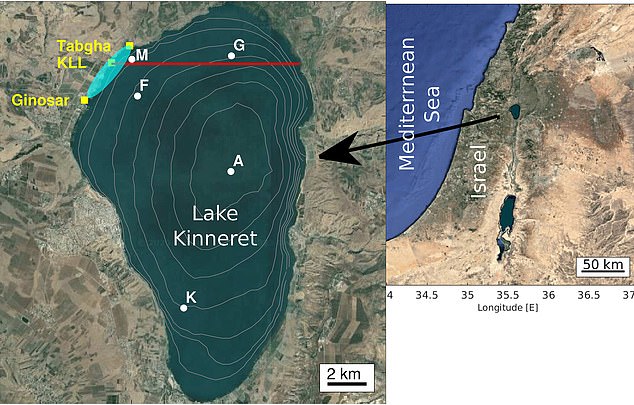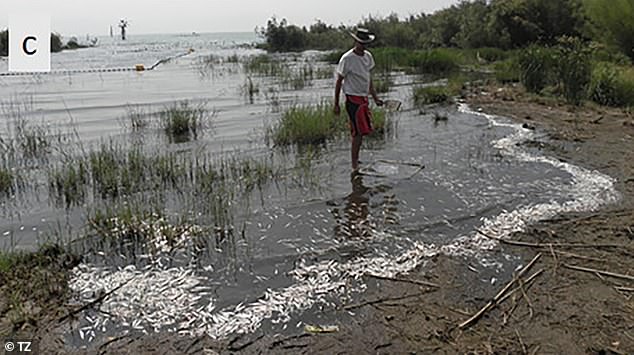Scientists have discovered a possible explanation behind how Jesus performed one of his most famous miracles.
The Bible includes two accounts of Christ turning fishermen’s failed fishing attempts into massive hauls that fed their communities for weeks.
Known as the “miraculous fish catch,” miracles were said to have been performed at Israel’s Lake Kinneret, where Jesus preached.
Now, a new study has found that a natural phenomenon that occurs at certain times of the year may have played a role.
Researchers at the Kinneret Limnological Laboratory in Israel have discovered that there are much lower levels of oxygen deep in the Kinneret Lake basin.
This is due to an increase in the proliferation of phytoplankton that blocks oxygen and causes fish to suffocate.
They identified two events in 2012 in which thousands of dead fish floated to the surface along 2.4 miles of the lake’s shoreline.
The researchers wrote: “(Our study) may explain the appearance of large numbers of easy-to-harvest fish near the coast, as described in biblical narratives.”
Biblical story of Jesus’ miraculous catch could be full of reality, researchers found

Lake Kinneret is believed to be the same body of water mentioned in the New Testament, called the Sea of Galilee.
Researchers said the theory supports the idea that Jesus and his miracles of pulling more than a hundred fish out of the sea were real.
However, the study’s revelations have called into question whether Jesus’ actions were truly miracles or whether they simply coincided with the natural elements of the lake.
The miraculous fishing occurred in two events and appears in the books of Luke and John: one in 27 AD before his resurrection and another after his resurrection in 29 AD
The miracles occurred at Lake Kinneret, believed to be the biblical Sea of Galilee mentioned in the New Testament.
In one story, Jesus commanded Simon Peter, a fisherman who had caught nothing that night, to cast his net into the water once more.
Peter obeyed Jesus and caught so many fish that the nets almost broke, forcing them to ask another boat to help them bring the fish to shore.
In John 21:11, the Bible describes the scene by saying: ‘Simon Peter got into the boat and dragged the net ashore. It was full of 153 large fish, but even with so many the net did not break.’
Jesus appeared again to his disciples after his resurrection in the Book of John and repeated the miracle by instructing them to cast the net to the right side of the boat, resulting in another great haul.

Researchers set out to discover why hundreds of dead fish washed up on the shore of Lake Kinneret in 2012. They discovered that a lack of oxygen in the water had caused the fish to suffocate to death.
The researchers set out to discover what could have caused fishermen to easily access thousands of fish.
They placed sensors in the lake to track temperatures in the water column and wind direction and speed and the data suggested that the water’s low oxygen levels were driven by strong winds blowing from the west.
Yael Amitai, a physical limnologist at the Kinneret laboratory, told Israel Times: ‘The Sea of Galilee is a stratified lake. The top layer is warm and oxygenated, while the bottom layer is cold and lacks oxygen.’
Lake Kinneret is a warm monomythic lake, meaning the surface temperature never drops below 39 degrees Fahrenheit and will separate into layers of water with different temperatures due to the difference in water density.
This process, called thermal stratification, occurs twice a year and mixes the colder top layer with the colder bottom layer of water to transport oxygen and nutrients throughout the lake.
Within four to six weeks of thermal stratification that occurs from March to April, Lake Kinneret becomes anoxic, meaning it is essentially devoid of oxygen and unable to support most aquatic life.
According to the study, zooplanktivorous cyprinids, which are the most abundant fish species in the lake, were mainly found along the lake shore in 2012, but some larger dead fish, such as carp, catfish, tilapia, were also discovered. and barbels.
This phenomenon is not uncommon, according to the researchers, who said it also occurred in Lake Erie and the Neuse River estuary in North Carolina.
However, it occurs sparingly: the case at Lake Kinneret was reported only two other times in April 2007 and the early 20th century. The exact date was not recorded.
The study states that these “fish kill events occur only in years with intense spring phytoplankton blooms.”
Phytoplankton is a microscopic algae that uses sunlight to make its own food, but when a species reproduces rapidly, it can produce toxins that create oxygen-depleted dead zones that can kill fish.
“Our study suggests a location and time frame for biblical miracles near Tabgha, documented in the Miracle of the Loaves and Fishes and the Miraculous Fishing,” the researchers wrote in the paper published in the journal. Water resources research.
They suggested that the lake conditions at that time were similar to those seen now and that 2,000 years ago (when the biblical miracles occurred), the Lake Kinneret basin was densely inhabited by farmers numbering about 200,000, which is similar to the current population. in the region.”

